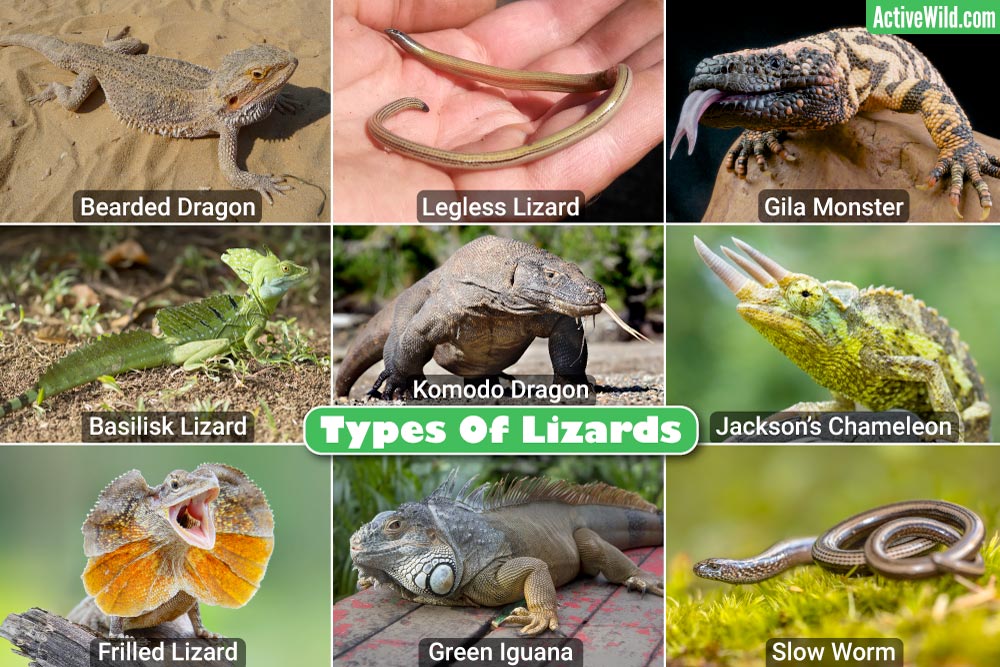Well-known types of lizards include the Komodo dragon (the world’s largest lizard); Gila monster (a venomous desert lizard); green iguana (a large, tree-dwelling lizard); frilled lizard (which raises a brightly-colored ruff when threatened); Texas horned lizard (able to squirt blood from its eyes); legless lizards that resemble snakes; and flying lizards that glide from tree to tree in rainforests.
On this page is a list containing these and many more types of lizards. You'll gain a comprehensive overview of lizard diversity and discover interesting facts on the lifestyles of these amazing reptiles. For each species, we have included pictures, fun facts, conservation status and links to further information.
Page Index
Types Of Lizards
- Argentine Black And White Tegu
- Asian Water Monitor
- Coal Skink
- Mexican Beaded Lizard
- Texas Alligator Lizard
- Bearded Dragon
- California Legless Lizard
- Common Basilisk
- Common Lizard
- Flying Lizard
- Frilled Lizard
- Gila Monster
- Green Anole
- Green Iguana
- Jackson's Chameleon
- Komodo Dragon
- Leopard Gecko
- Marine Iguana
- New Mexico Whiptail
- Perentie
- Satanic Leaf Tailed Gecko
- Slow Worm
- Solomon Islands Skink
- Texas Horned Lizard
- Thorny Devil
- Bonus Lizard: Mosasaur
Related Pages:
- You can find out more about reptiles on this page: Reptiles - The Ultimate Guide
- Discover amazing snakes from all around the world: Types Of Snakes
- Discover amazing turtles from all around the world: Types Of Turtles
- Discover amazing reptiles from all around the world: Types Of Reptiles
- Discover amazing animals from all around the world on this page: A to Z Animals List
- View and buy interesting books about reptiles: Reptile Books
Lizards
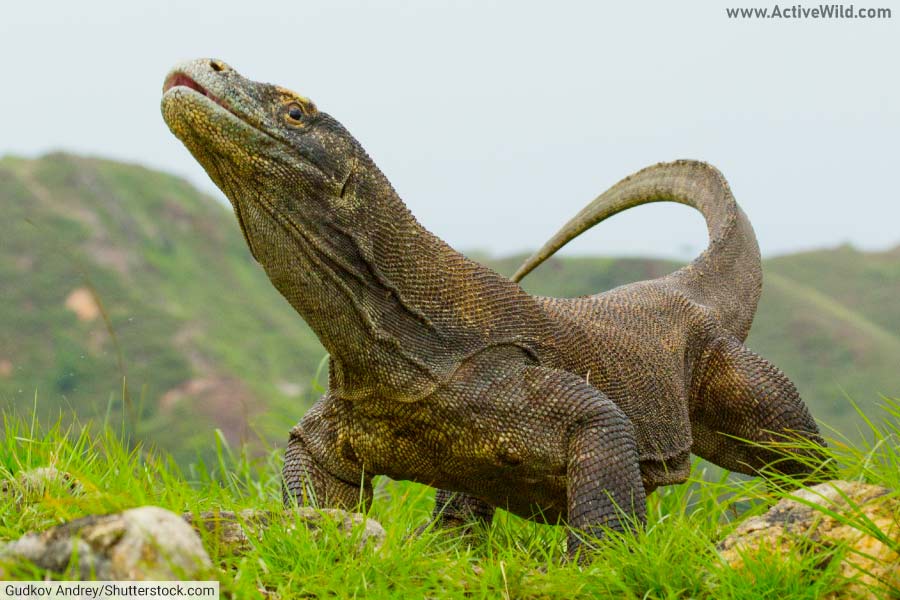
Lizards are reptiles belonging to the order Squamata, which is also home to snakes (some types of lizards are more closely related to snakes than they are to other lizard species).
Animals in the order Squamata are known as "squamates".
There are over 7,000 lizard species (as of June 2022, the Reptile Database lists 7,176 species ), and lizards make up around 63% of all known squamates. Lizard species outnumber snake species by about 1.8 to 1. Lizards are found on all continents except Antarctica.
Most lizards are carnivores, but not all; several species are almost entirely herbivorous.
Large lizards such as the Komodo dragon and perentie are apex predators, sitting at the top of the food chain with no natural predators of their own.
Most lizards, however, are found lower down the food chain, and have to avoid predators while hunting their own prey.
Most lizards have four limbs. Some lizards are able to walk on just their hind legs for short periods, and some lizards have lost their limbs entirely, sliding snake-like across the ground. Flying lizards glide from tree to tree on special “wings”.
Lizards make interesting and unusual pets, and several species in the list below are found not only in their native habitats, but also in vivariums all around the world.
Below is a list of lizards containing examples of many different types of lizards, with pictures and facts on each species.
Sources Of Data For This Article
Data for the current number of lizard and other squamate species was taken from the Reptile Database
Much of the data on the number of species per genus, etc. was taken from the Catalogue of life.
The conservation status of individual species comes from the IUCN Redlist.
Types Of Lizards: A List Of Lizard Species From All Around The World
Argentine Black And White Tegu
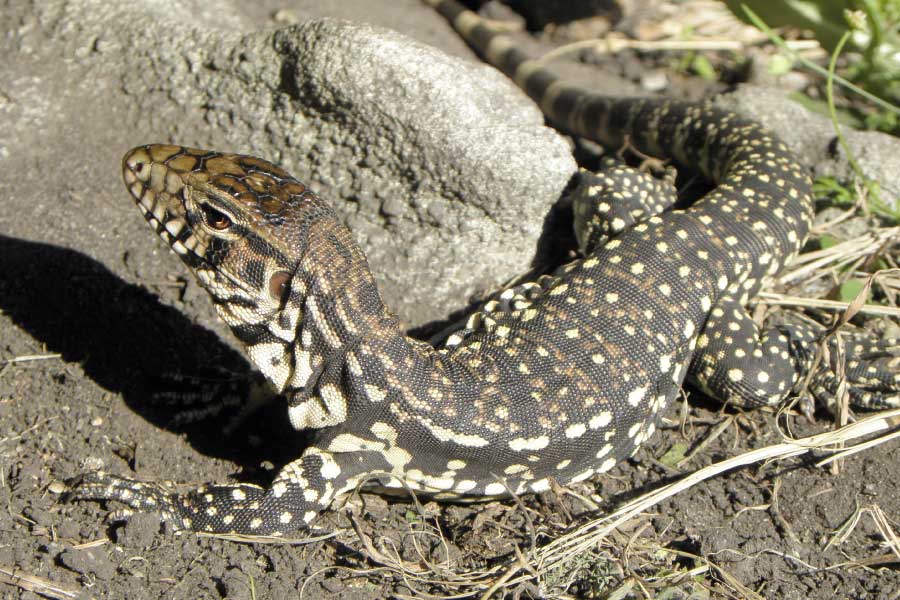
Scientific name: Salvator merianae
Family: Teiidae
Where found: South America
Conservation status: Least Concern
Fun fact: Tegus and monitor lizards may appear similar in both appearance and behavior, but are found on different continents and are not closely related. This is an example of convergent evolution (the process by which unrelated species evolve similar characteristics).
The Argentine black and white tegu is the largest of the tegus, a group of Central and South American lizards that resemble monitor lizards such as the perentie in both appearance and behavior.
Although young Argentine black and white tegus are green, they soon acquire their characteristic black and white color. Males, which are up to 50% larger than females, grow to lengths of up to 1.37 m / 4.5 ft.
The Argentine black and white tegu is an omnivore. Its diet includes a variety of animals, ranging from insects to small mammals, and plant material such as fruit and seeds. It is particularly fond of the eggs of both birds and other reptiles.
Discover More With Active Wild
You can see more black and white animals on this page: Black and White Animals List with Pictures & Facts
Asian Water Monitor
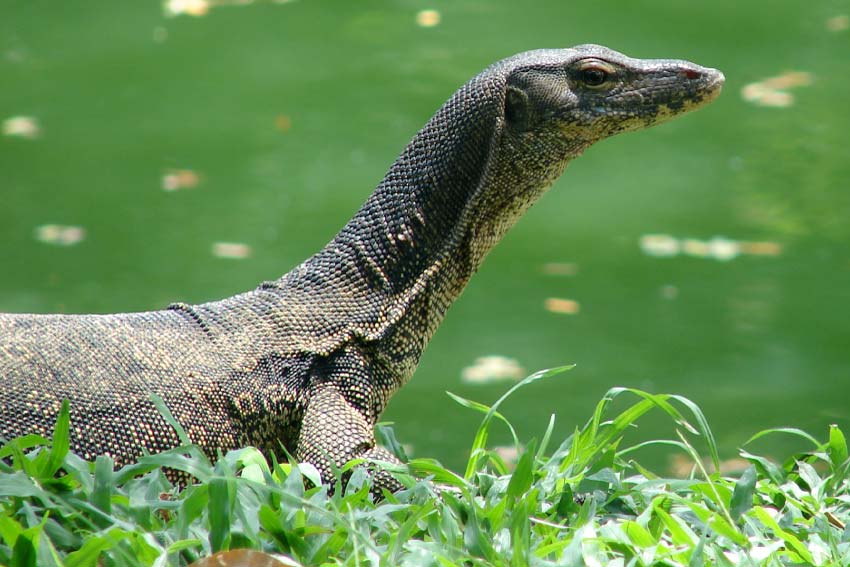
Scientific name: Varanus salvator
Family: Varanidae
Where found: Asia
Conservation status: Least Concern
Fun Fact: The Asian water monitor is the world’s longest lizard
With a maximum recorded length of 3.21 m / 10.53 ft., the Asian water monitor is the world’s longest lizard, but only the second-largest, as it weighs significantly less than the Komodo dragon.
The Asian water monitor is a member of the family Varanidae, which is home not only to all monitor lizards (including the Komodo dragon), but also to goannas and other, related types of lizards.
Found in numerous south and Southeast Asian countries, the Asian water monitor inhabits forests and mangrove swamps. As its name suggests, the species is semi-aquatic and an excellent swimmer. It is always found near water.
The Asian water monitor is a generalist carnivore, preying on a wide range of animals, including fish, rodents and even young crocodiles.
Discover More With Active Wild
Discover more Asian animals on this page: Asian Animals List with Pictures & Facts
Coal Skink

Scientific name: Plestiodon anthracinus
Family: Scincidae
Where found: North America
Conservation status: Least Concern
Fun fact: As hatchlings, coal skinks have blue tails.
The coal skink is a member of the skink family Scincidae found only in the United States. It has a scattered population divided into two subfamilies: the Northern coal skink, Plestiodon anthracinus anthracinus; and Southern coal skink, Plestiodon anthracinus pluvialis.
The coal skink has an average length of around 15.5 cm / 6.1 in., and ranges in color from orange-brown to dark grey. It has four light stripes running along its back and sides.
This American lizard is found in a variety of habitats, including forests, grasslands and rocky areas. Like most lizards, it lays eggs.
Discover More With Active Wild
You can see more North American reptiles on this page: American Reptiles List with Pictures & Facts
Mexican Beaded Lizard

Scientific name: Heloderma horridum
Family: Helodermatidae
Where found: North America, Central America
Conservation status: Least Concern
Fun fact: Until recently, there was only one beaded lizard species. Today, four species are recognized, after regional differences were considered great enough for each population to be considered a separate species.
The Mexican beaded lizard, like the closely related Gila monster, produces venom with special glands in its lower jaw. Although rarely fatal to humans, a bite from the species is extremely painful. As a result of its perceived danger, the species is often persecuted by humans.
Until recently, the Mexican beaded lizard was a single species with four subspecies. Each of these is now considered an individual species, meaning that the genus Heloderma now contains five species, including the Gila monster.
The beaded lizards get their name from the bobbled, beaded appearance of their scales. This is caused by osteoderms (bony deposits) which provide additional protection.
Discover More With Active Wild
Find out more about the Gila monster on this page: Gila Monster Facts
You can see more North American reptiles on this page: American Reptiles List with Pictures & Facts
Texas Alligator Lizard

Scientific name: Gerrhonotus infernalis
Family: Anguidae
Where found: North America
Conservation status: Least Concern
Fun fact: The Texas Alligator lizard is the largest lizard found in Texas.
The Texas alligator lizard is one of nine alligator lizards of genus Gerrhonotus, so-named due to their alligator-like appearance.
The largest lizard in Texas, the Texas alligator lizard reaches lengths of up to 64 cm / 25 in. It has brown-green skin and large, square scales. Crossing its back are a series of black and white stripes.
The Texas alligator lizard inhabits a variety of forest and shrubland habitats. It is typically found in rocky areas near streams.
Discover More With Active Wild
You can see more North American reptiles on this page: American Reptiles List with Pictures & Facts
Bearded Dragon

Family: Agamidae
Genus: Pogona
Where found: Australia
Fun fact: Bearded dragons are named after their beard-like throats, which enlarge and change color when the lizard is threatened.
Bearded dragons are mid-sized lizards with flat bodies, triangular heads and spiny scales on their sides, tails and faces. Their “beards” are spiny-scaled throat pouches that enlarge and change color when the lizard is threatened.
There are six species of bearded dragon. Together they make up the genus Pogona, which is part of the Agamidae family. Bearded dragons are native to Australia.
Bearded lizards grow to a maximum length of around 60 cm / 2 ft. They are good climbers, and are often found in trees. They inhabit deserts and other arid habitats.
The central bearded dragon, Pogona vitticeps, is one of the most common pet reptiles.
Discover More With Active Wild
You can see more Australian reptiles on this page: Australian Reptiles List with Pictures & Facts
Discover more Australian animals on this page: Australian Animals List with Pictures & Facts
California Legless Lizard

Scientific name: Anniella pulchra
Family: Anniellidae
Where found: North America
Conservation status: Least Concern
Fun fact: Legless lizards can be differentiated from snakes by their movable eyelids and external ear openings, neither of which are found in snakes.
The California legless lizard is one of just six species in the American legless lizard family, Anniellidae. As the name suggests, these lizards lack limbs and move in a snake-like manner.
A burrowing animal, the California legless lizard is found in sand dunes and areas with loose soil in California, USA and Mexico.
The California legless lizard is around 20 cm / 7.87 in. in length. The species’ color varies, ranging from silver to metallic brown, often with yellow undersides.
The American legless lizards are one of several lizard groups whose legs have been lost as they evolved. Both lizards and snakes belong to the reptile order Squamata.
Discover More With Active Wild
You can see more North American reptiles on this page: American Reptiles List with Pictures & Facts
Common Basilisk
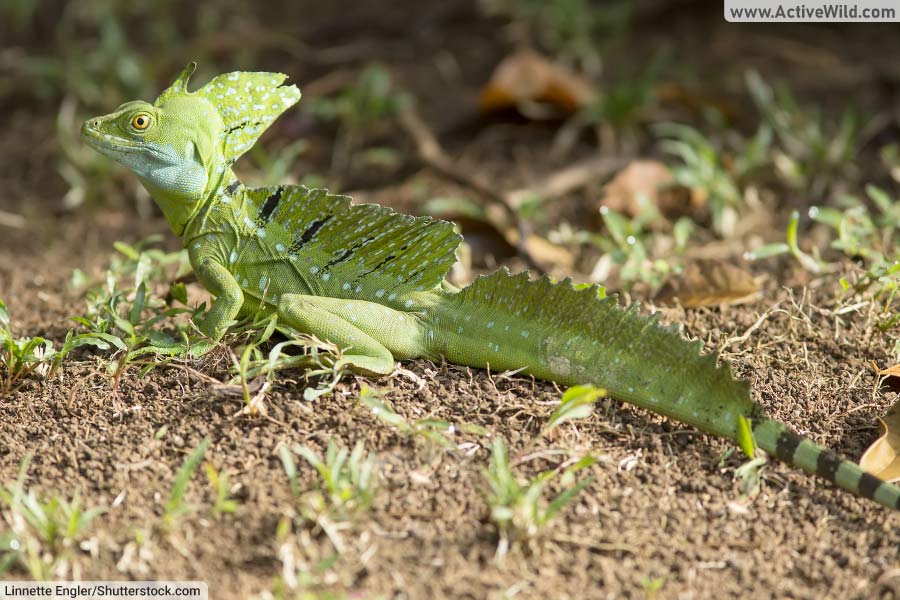
Scientific name: Basiliscus basiliscus
Family: Corytophanidae
Where found: Central America, South America
Conservation status: Least Concern
Fun fact: As well as being able to walk on water, the common basilisk is an excellent swimmer and climber.
The common basilisk lizard is one of nine species in the “casquehead” lizard family, Corytophanidae. Like other members of this family, the male common basilisk has crests on its head, back and tail.
The common basilisk is a relatively large lizard, growing to around 0.8 m / 2.62 ft. in length. The species is brown / olive-green in color, with darker stripes on the back. It usually lives near rivers, and is found in tropical rainforests from southern Nicaragua in Central America to Colombia and Venezuela in South America.
The common basilisk lizard is nicknamed the “Jesus Christ lizard” due to its ability to run across the surface of water on its hind legs. The lizard uses this ability to escape from potential predators.
Special scales on the lizard’s large hind feet allow it to cover distances of up to 20 m / 65.6 ft. before sinking (the common basilisk is also an excellent swimmer).
Discover More With Active Wild
Discover more rainforest reptiles on this page: Rainforest Reptiles List with Pictures & Facts
You can see more rainforest animals on this page: Rainforest Animals List with Pictures & Facts
Common Lizard
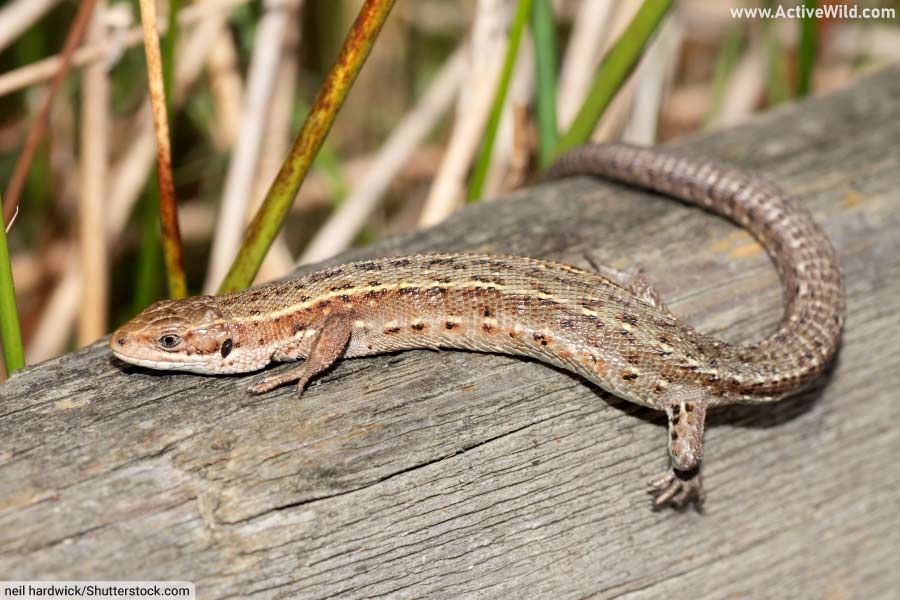
Scientific name: Zootoca vivipara
Family: Lacertidae
Where found: Europe, Asia
Conservation status: Least Concern
Fun fact: The common lizard is the only reptile native to Ireland (and one of only three lizards native to Great Britain)
With a range stretching from Spain to Japan and including the British Isles and Scandinavia, the common lizard is found across a wider area – and further north – than any other lizard.
This small lizard has a maximum length of 7 cm / 2.76 in. and is typically brown in color with darker and lighter spots and stripes, although many other color variations are known.
The common lizard is among the relatively small number of lizards that give birth to live young, rather than laying eggs. The species’ alternative name, Viviparous lizard, reflects this method of reproduction (viviparity = live birth).
Discover More With Active Wild
You can see more British reptiles on this page: British Reptiles List
Discover more Asian animals on this page: Asian Animals List with Pictures & Facts
Flying Lizard

Genus: Draco
Family: Agamidae
Where found: Asia
Fun fact: flying lizards can glide up to 9.14 m / 30 ft.
Lizards of genus Draco are also known as flying lizards, flying dragons and gliding lizards. Members of this group, which contains around 39 species, have a flap of skin, known as a patagium, on either side of their bodies. When extended on specially-lengthened rib bones, the patagium acts as a wing, allowing the lizards to glide through the air.
Flying lizards can’t actually fly; unlike birds, these little reptiles are incapable of flapping flight, nor are they able to launch themselves into the air from the ground.
Flying lizards use their gliding ability both as a means of escaping from predators and as a means of getting around the forest; gliding from tree to tree is much more energy-efficient than climbing.
These insectivorous (insect-eating) lizards spend almost their whole lives in the trees, and are rarely seen on the forest floor.
Discover More With Active Wild
Discover more rainforest reptiles on this page: Rainforest Reptiles List with Pictures & Facts
You can see more rainforest animals on this page: Rainforest Animals List with Pictures & Facts
Discover more Asian animals on this page: Asian Animals List with Pictures & Facts
Frilled Lizard
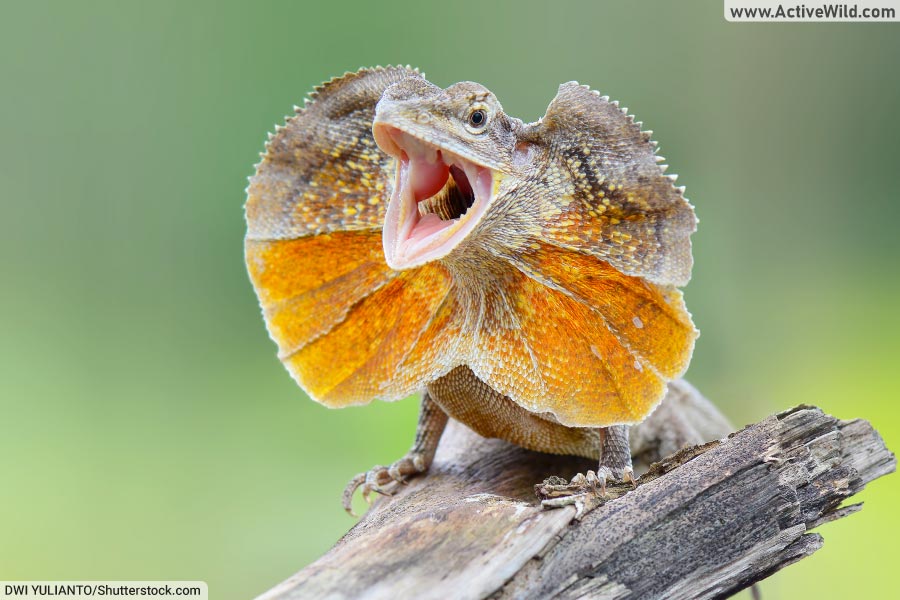
Scientific name: Chlamydosaurus kingii
Family: Agamidae
Where found: Australia, New Guinea
Conservation status: Least Concern
Fun fact: The Dilophosaurus in Jurassic Park was portrayed with a neck frill similar to that of the frilled lizard (there is no evidence that the real Dilophosaurus had such a frill).
The frilled lizard, also known as the frill-necked lizard, is a lizard found in northern Australia and southern New Guinea. It belongs to the agamid family, Agamidae, which is home to over 300 lizard species.
The frilled lizard is famous for its threat display, which consists of the lizard raising a large, brightly-colored frill around its head. This is often enough either to startle a would-be predator or to intimidate a rival.
The frilled lizard is grey to orange-brown in color. This coloration serves as camouflage; the lizard is typically found on tree trunks. A large lizard, the frilled lizard has a nose to tail length of up to 85 cm / 2.79 ft. It is capable of walking bipedally (i.e., using only its hind legs).
Discover More With Active Wild
You can find out more about the frilled lizard on this page: Frilled Lizard Facts
You can see more Australian reptiles on this page: Australian Reptiles List with Pictures & Facts
Discover more Australian animals on this page: Australian Animals List with Pictures & Facts
Gila Monster
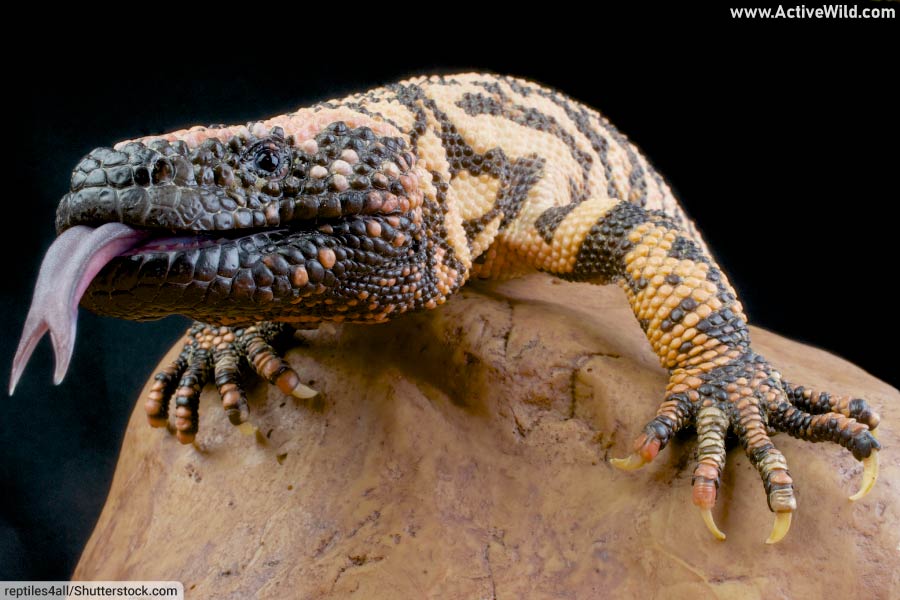
Scientific name: Heloderma suspectum
Family: Helodermatidae
Where found: North America
Conservation status: Near Threatened
Fun fact: The Gila monster is the only venomous lizard found in the United States
The Gila monster is one of five species in the beaded lizard family, Helodermatidae. Unlike virtually all other lizards (the exceptions being some monitor lizards), all five beaded lizards are venomous.
Reaching lengths of up to 0.56m / 1.84 ft., the Gila monster is the largest lizard native to the United States. Its size, distinctive orange and black coloration, and venomous bite, have given the species a fearsome reputation, which, in reality, is undeserved. A bit from the slow-moving lizard, despite being extremely painful, is rarely fatal to humans.
The Gila monster is found in southwestern United States and Sonora, Mexico. It inhabits desert grasslands and scrublands.
Discover More With Active Wild
You can find out more about the Gila monster on this page: Gila Monster Facts
You can see more North American reptiles on this page: American Reptiles List with Pictures & Facts
Green Anole

Scientific name: Anolis carolinensis
Family: Dactyloidae
Where found: North America
Conservation status: Least Concern
Fun fact: Despite being nicknamed the “American Chameleon” due to its color-changing ability, the green anole is not closely related to “true” chameleons.
The green anole is a medium-small lizard found in southwestern United States. It grows to lengths of up to 20 cm / 8 in, with the lizard’s tail making up over half of its total length.
The green anole is nicknamed the “American Chameleon” due to its ability to change color from green to brown. The chameleon’s color is dependent on its environment.
Despite its color-changing ability, the green anole is not a true chameleon, and belongs to the anole family, Dactyloidae, rather than the chameleon family, Chamaeleonidae.
The male green anole has a large, extendable pink dewlap (flap of skin) on its throat. This is used to display to females and as a threat to rival males.
Discover More With Active Wild
You can see more North American reptiles on this page: American Reptiles List with Pictures & Facts
Green Iguana
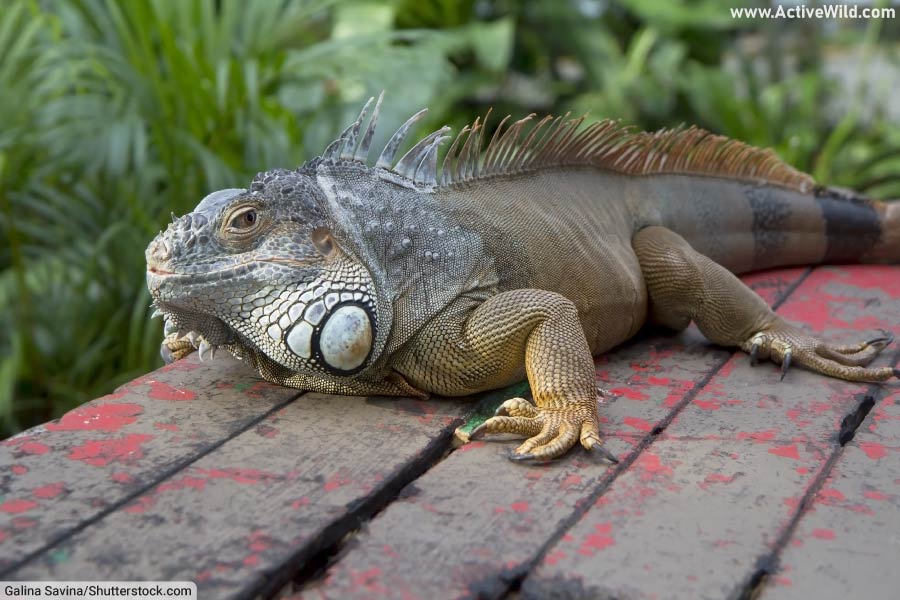
Scientific name: Iguana iguana
Family: Iguanidae
Where found: South America, North America
Conservation status: Least Concern
Fun fact: Despite its name, the green iguana is not always green. Depending on where it is found, the species can be blue, red, orange, black or brown.
The green iguana is a large, arboreal (tree-dwelling) lizard found in tropical rainforests from Brazil to Mexico. The largest specimens reach lengths of over 2 m / 6.56 ft. and weigh up to 8 kg / 17.6 lb., although a typical length for a large iguana is around 1.7 m / 5.6 ft.
The green iguana is herbivorous, feeding on leaves and fruit. It spends most of its life in the trees, but will also excavate burrows (or use those of other animals). It is a capable swimmer, propelling itself through the water with its tail.
Discover More With Active Wild
You can find out more about the green iguana on this page: Iguana Facts
Discover more rainforest reptiles on this page: Rainforest Reptiles List with Pictures & Facts
You can see more rainforest animals on this page: Rainforest Animals List with Pictures & Facts
Jackson's Chameleon
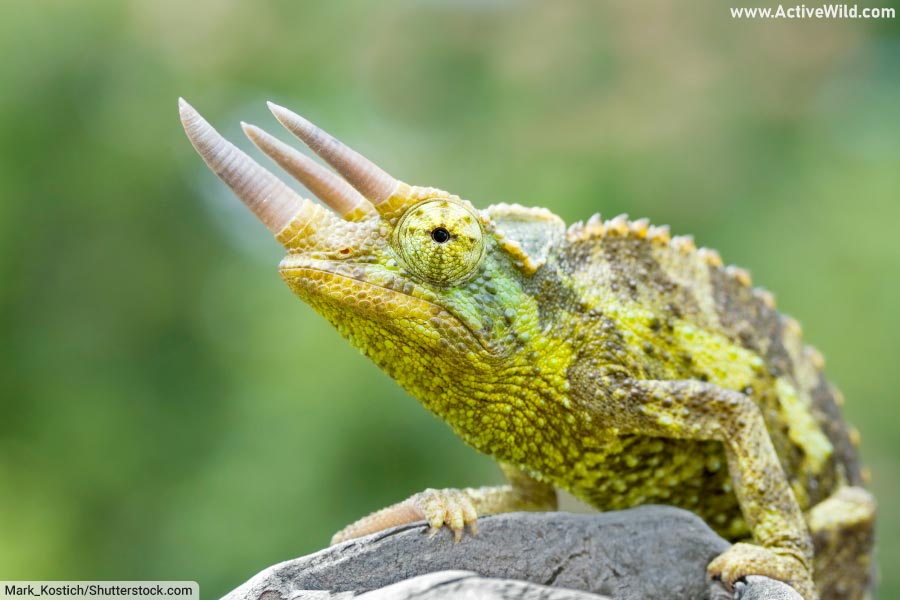
Scientific name: Trioceros jacksonii
Family: Chamaeleonidae
Where found: Africa
Conservation status: Least Concern
Fun fact: Unlike most other chameleons, Jackson’s chameleon gives birth to live young rather than laying eggs.
Jackson’s chameleon is a member of the chameleon family Chamaeleonidae found in forests in East Africa.
Like other chameleons, Jackson’s chameleon is able to change color. It is typically leaf-green, but under various environmental, emotional or health conditions will change to various other shades, including black, blue-grey and olive-green.
Male Jackson’s chameleons are among the most striking-looking of all lizards due to their three prominent horns (one next to each eye, the other on the nose).
Discover More With Active Wild
You can see more "ugly animals" on this page: Ugly Animals List with Pictures
Discover more African reptiles on this page: African Reptiles List with Pictures
Komodo Dragon

Scientific name: Varanus komodoensis
Family: Varanidae
Where found: Asia
Conservation status: Endangered
Fun fact: the Komodo dragon is considered the world’s largest lizard due to its weight, but the Asian water monitor is longer.
The Komodo dragon is the world’s largest lizard. The largest recorded individual was 3.13 m / 10.27 in length, and the average length of a wild Komodo dragon is around 2.44 m / 8 ft.
An apex predator with no predators of its own, the Komodo dragon eats deer, wild pigs, water buffalo, and most other vertebrates it can catch, including other Komodo dragons. The species also eats carrion.
Scientists have recently discovered that the saliva of the Komodo dragon contains toxins, meaning that the species is one of the very few venomous lizards.
This giant Asian lizard is found only on four islands: Komodo, Rinca, Flores, and Gili Motang, all of which belong to the island country Indonesia.
Discover More With Active Wild
You can find out more about the Komodo dragon on this page: Komodo Dragon Facts
Discover more Asian animals on this page: Asian Animals List with Pictures & Facts
Leopard Gecko

Scientific name: Eublepharis macularius
Family: Eublepharidae
Where found: Asia
Conservation status: Least Concern
Fun fact: Because the leopard gecko is bred in captivity in large numbers for the pet trade, it is considered to be the first domesticated lizard.
The leopard gecko belongs to the family Eublepharidae. Members of this family are unlike other geckos in that they have eyelids, and as a result, are known as “eyelid geckos”.
The leopard gecko, with its dark spots and pale yellow color, is named after the big cat it resembles. Like the real leopard, the leopard gecko is a carnivore, although its prey is somewhat smaller, consisting of insects and small vertebrates (the species is known to prey on its young, although this may be a result of a lack of alternative food).
Reaching an average length of around 21.5 cm / 8.46 in. (males tend to be slightly bigger), this mid-sized lizard is a popular pet.
Discover More With Active Wild
Discover more Asian animals on this page: Asian Animals List with Pictures & Facts
Marine Iguana
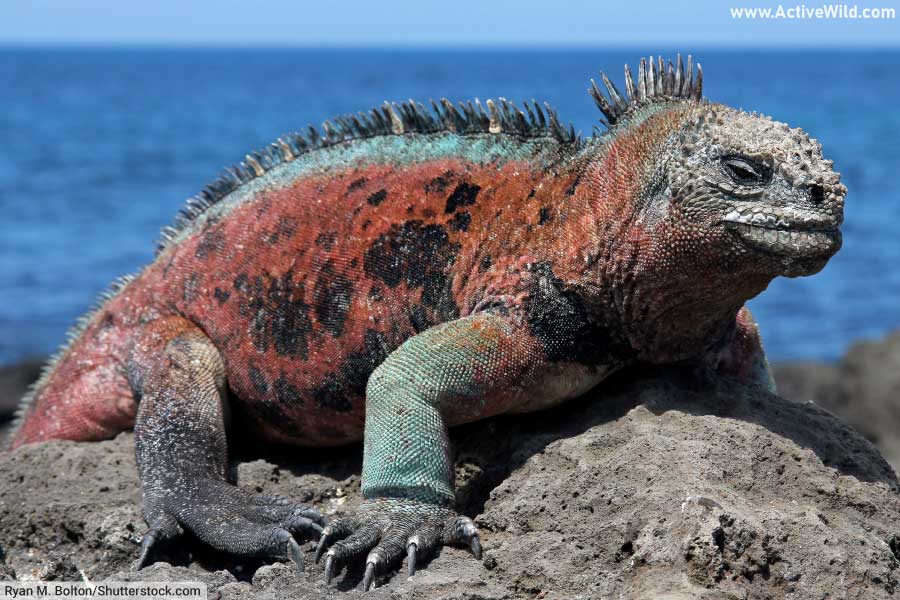
Scientific name: Amblyrhynchus cristatus
Family: Iguanidae
Where found: Galápagos Islands
Conservation status: Vulnerable
Fun fact: The marine iguana is the only marine lizard.
The marine iguana is the only lizard considered to be a marine reptile. It regularly enters the sea to forage for the red and green algae on which it lives. Large males make lengthy dives to depths of up to 39 m / 984 ft., while smaller individuals forage in the intertidal zone.
With a maximum length of around 1.4 m / 4.59 ft., the marine iguana is slightly smaller than the “typical” green iguana, found on the Central and South American mainland.
The marine iguana is typically black in color, with males becoming brighter during the breeding season. Males in some areas are more colorful, having patches of red and other colors.
The marine iguana is endemic to (only found on) the Galápagos Islands, an Ecuadorian archipelago in the Pacific Ocean. Also endemic to the islands are the Galápagos land iguanas, and hybrids between marine and land iguanas are known.
Discover More With Active Wild
You can see more ocean animals on this page: Ocean Animals List with Pictures
New Mexico Whiptail

Genus: Aspidoscelis neomexicanus
Family: Teiidae
Where found: North America
Conservation status: Least Concern
Fun fact: All New Mexico whiptails are females.
The New Mexico whiptail is a small lizard belonging to the family Teiidae, which is home to whiptails, racerunners and tegus. It is found in New Mexico and Arizona in the United States, and Chihuahua in Mexico. The species is the state reptile of New Mexico.
With an average length of around 8 cm / 3.15 in., the New Mexico whiptail is black with seven yellow-white stripes running from its head to its tail.
The New Mexico whiptail is a hybrid of two other whiptail species: the little striped whiptail and the western whiptail. This mating only produces females, but because the New Mexico whiptail is parthenogenetic (i.e., its egg cell can develop into an embryo without having been fertilized), the species is able to reproduce. As a result, all New Mexico whiptails are female.
Discover More With Active Wild
You can see more North American reptiles on this page: American Reptiles List with Pictures & Facts
Perentie
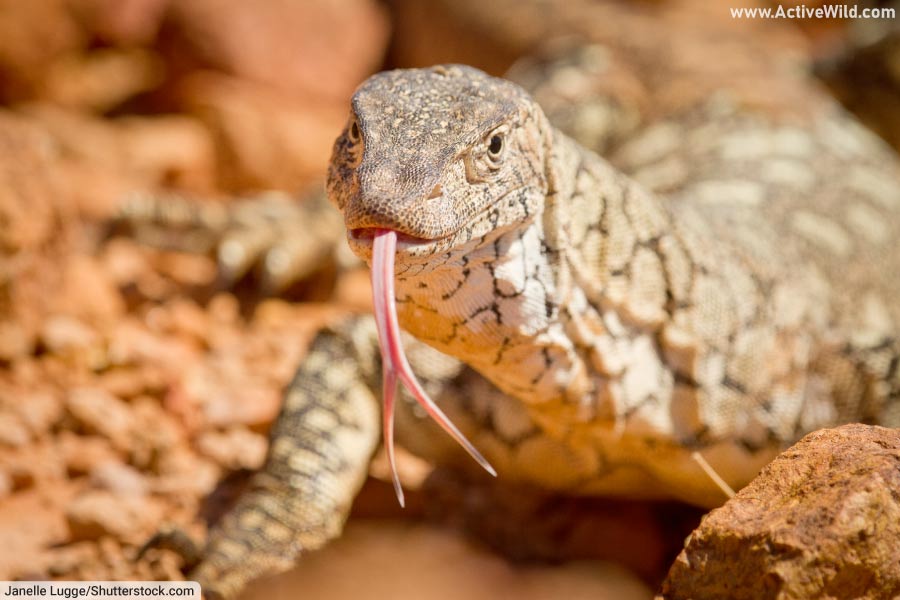
Scientific name: Varanus giganteus
Family: Varanidae
Where found: Australia
Conservation status: Least Concern
Fun fact: Perenties often stand on their hind legs (supported by their tails) in order to view their surroundings; a behavior known as “tripoding”.
The perentie is a large monitor lizard found in rocky and desert habitats in Australia. Reaching lengths of up to 2.5 m / 8.2 ft and weights of over 20 kg / 44 lb., the perentie is a similar size to both the Crocodile monitor and Nile monitor, but smaller than the Komodo dragon and Asian water monitor. (It is therefore either the world’s third, fourth or fifth-largest living lizard.)
The perentie is an apex predator, armed not only with sharp teeth, claws and a powerful tail, but also with venomous saliva which increases the efficacy of its already powerful bite.
Unsurprisingly, the perentie is an apex predator, with no natural predators of its own. Its diet consists of a wide variety of vertebrates, with reptiles – including other monitor lizards and even other perenties – forming a significant proportion of its prey.
The perentie is the largest “goanna” – a group of Australian lizards of genus Varanus named by early European settlers for their (loose) resemblance to iguanas.
Discover More With Active Wild
You can find out more about the perentie on this page: Perentie Facts
You can see more Australian reptiles on this page: Australian Reptiles List with Pictures & Facts
Discover more Australian animals on this page: Australian Animals List with Pictures & Facts
Satanic Leaf Tailed Gecko
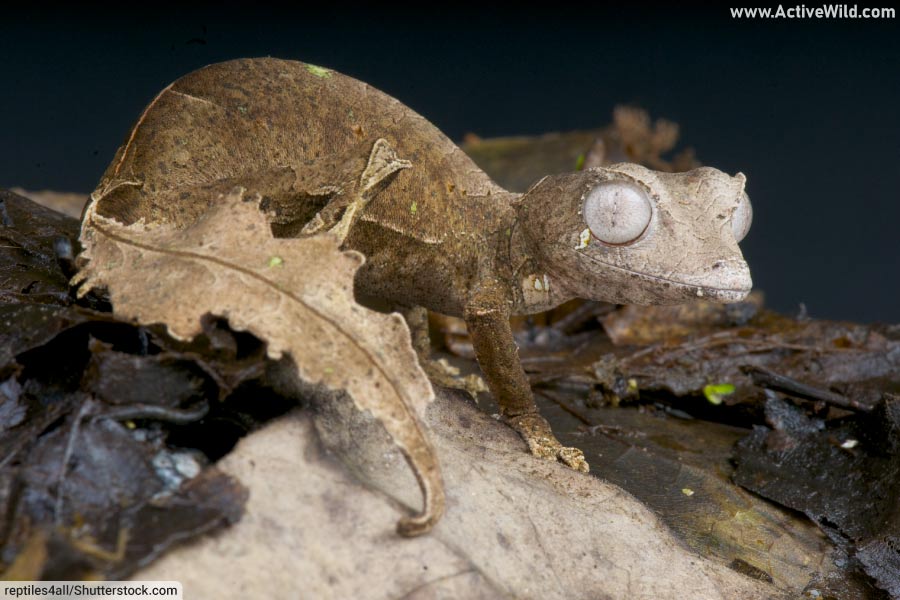
Scientific name: Uroplatus phantasticus
Family: Gekkonidae
Where found: Madagascar
Conservation status: Least Concern
Fun fact: The Satanic leaf-tailed gecko’s large eyes are an adaptation for a nocturnal lifestyle.
The satanic leaf-tailed gecko is one of 21 geckos of genus Uroplatus, a sub-group of the family Gekkonidae. These lizards, all of which are only found on the African island-country Madagascar, are masters of camouflage, equipped with specially-adapted, flat or leaf-shaped tails for hiding among the trees.
The satanic leaf-tailed gecko is found in the humid, tropical forests in eastern Madagascar. It grows to a length of around 9 cm / 3.54 in., including its leaf-shaped tail. Spines on its head and back complete the lizard’s fearsome appearance, from which it gets its name.
Discover More With Active Wild
Discover more rainforest reptiles on this page: Rainforest Reptiles List with Pictures & Facts
You can see more rainforest animals on this page: Rainforest Animals List with Pictures & Facts
You can see more "ugly animals" on this page: Ugly Animals List with Pictures
Slow Worm
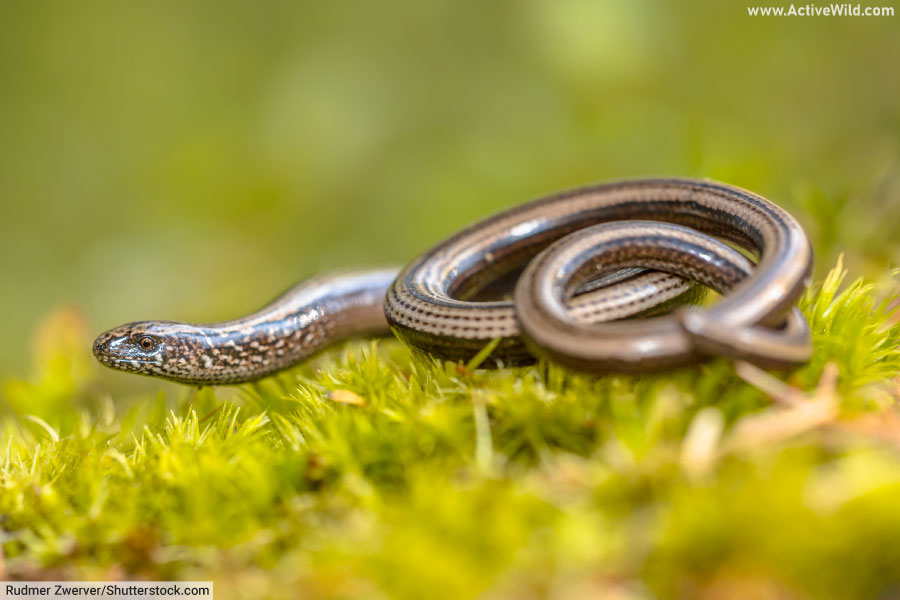
Scientific name: Anguis fragilis
Family: Anguidae
Where found: Europe
Conservation status: Least Concern
Fun fact: Like many lizards, the slow worm is able to shed its tail as a means of avoiding predation. The tail eventually regrows, but not to its original length.
The slow worm, despite its limbless, snake-like appearance, is a lizard. It is one of three recognized slow worm species of genus Anguis, which is one of several reptile groups that have lost their limbs.
The slow worm grows to a length of between 40 and 50 cm / 15.75 and 16.69 in., and has smooth, brown-gray skin. Males are paler and often have blue spots, while females have a dark stripe running along the back.
The slow worm feeds on slugs and worms. It lives in forests, woodlands, heathlands and gardens throughout western and central Europe.
Although the slow worm can occasionally be seen basking in the sun, it is mainly nocturnal and usually keeps itself hidden during the day. It has a semi-fossorial (burrowing) lifestyle, living in grass, loose earth and leaf litter.
Discover More With Active Wild
You can see more British reptiles on this page: British Reptiles List
Solomon Islands Skink

Scientific name: Corucia zebrata
Family: Scincidae
Where found: Solomon Islands
Conservation status: Near Threatened
Fun fact: Solomon Islands skinks live in a communal group known as a circulus. Such behavior is rare among reptiles.
The Solomon Islands skink is a lizard in the skink family, Scincidae, found only on the Solomon Islands – a group of islands in the Pacific Ocean north east of Australia. With an average length of around 64 cm / 25 in., the Solomon Islands skink is the world’s largest skink.
Unlike most lizards, the Solomon Islands skink is herbivorous, feeding on a variety of plant material including leaves and flowers.
The long, thick tail of the Solomon Islands skink is prehensile (able to grab), and is used when the lizard is climbing. The species is arboreal (tree-dwelling), spending much of its life in the trees.
The Solomon Islands skink is one of a very small number of reptiles that lives in a communal group. Members of the group, which is known as a circulus, protect one another’s young.
Discover More With Active Wild
Discover more amazing reptiles on this page: Examples Of Reptiles with Pictures
Texas Horned Lizard
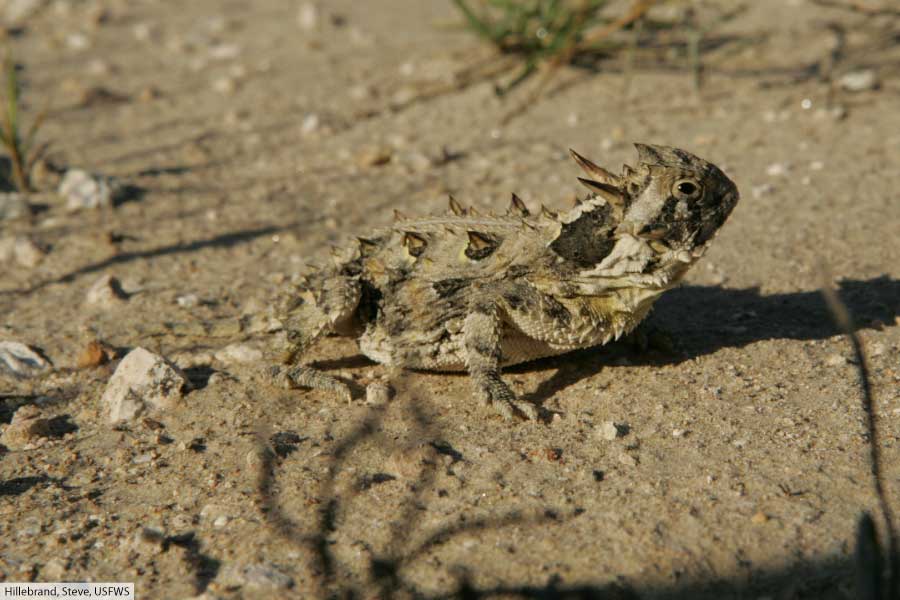
Scientific name: Phrynosoma cornutum
Family: Phrynosomatidae
Where found: North America
Conservation status: Least Concern
Fun fact: Like other horned lizards, the Texas horned lizard is able to project a stream of foul-tasting blood from its eyes if threatened by a predator.
The Texas horned lizard is one of a group of 21 small lizards known as horned lizards, or “horny toads”, which together make up the genus Phrynosoma. All horny toad species are found in North America.
With their squat, flat bodies, these lizards do have a slight resemblance to the amphibians after which they are named.
The Texas horned lizard is found not just in Texas, but also in several surrounding states and northern Mexico. It is the largest horned lizard found in the United States. It feeds mainly on ants and other small insects.
Discover More With Active Wild
You can see more North American reptiles on this page: American Reptiles List with Pictures & Facts
Thorny Devil
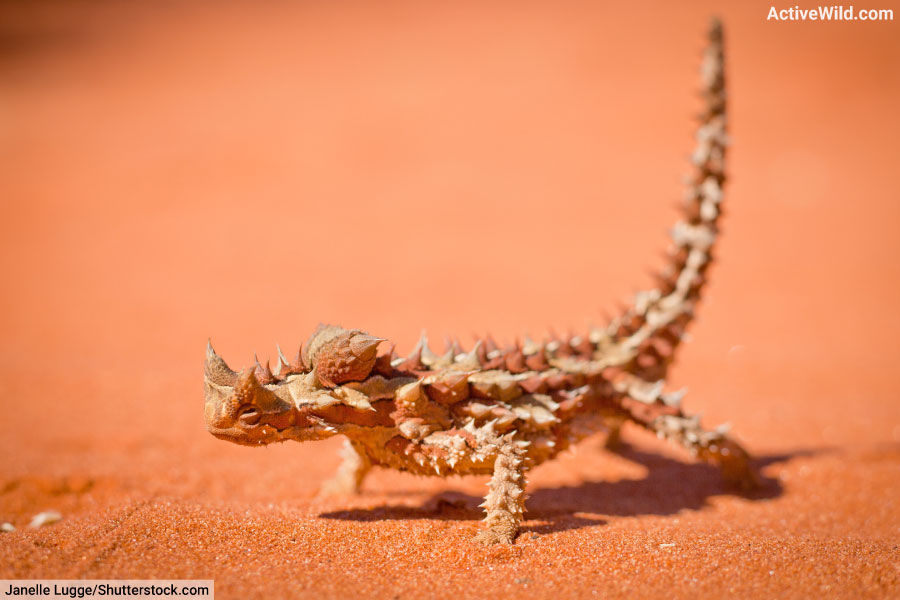
Scientific name: Moloch horridus
Family: Agamidae
Where found: Australia
Conservation status: Least Concern
Fun fact: Tiny grooves in the thorny devils’ skin transport water directly to its mouth. This allows the desert-living lizard to drink the dew that forms on its body overnight.
The thorny devil is a small lizard found in dry regions throughout most of central and west Australia.
The body and limbs of this desert-living lizard are covered in rows of spines, giving the animal a fearsome appearance and inspiring both its English and scientific names.
The “Moloch” part of the thorny devil’s scientific name refers to an ancient god whose followers took part in human sacrifice. The “horridus” part means, well, horrible.
Behind the thorny devil’s head is a “fake” head used to deter potential predators.
Discover More With Active Wild
You can find out more about the thorny devil on this page: Thorny Devil Facts
You can see more Australian reptiles on this page: Australian Reptiles List with Pictures & Facts
Discover more Australian animals on this page: Australian Animals List with Pictures & Facts
Bonus Lizard: Mosasaur

Scientific name: Mosasaur
Family: Mosasauridae
Where found: Europe, Asia, Australia, Antarctica
Conservation status: Extinct
Fun fact: Mosasaurs survived right to the end of the Cretaceous Period, becoming extinct in the Cretaceous-Paleogene Extinction Event that wiped out the dinosaurs.
Mosasaurs were a group of marine reptiles that lived during the Late Cretaceous. They were the dominant marine predators at the end of the Cretaceous Period, with both ichthyosaurs and pliosaurs having become extinct earlier in the epoch.
The largest mosasaurs reached lengths of around 15 m / 50 ft., and were the apex predators of the Late Cretaceous oceans. Their hands and feet had evolved into paddles, and their tails may even have had shark-like fins.
Many paleontologists believe that mosasaurs evolved from a (now extinct) group of marine lizards, the Aigialosaurids, and that their closest living relatives are monitor lizards. Others disagree, believing mosasaurs to be more closely-related to snakes.
Discover More With Active Wild
You can find out more about Mosasaurus on this page: Mosasaurus Facts
Discover more animals that lived in the Cretaceous Period on this page: Cretaceous Period Animals
Related Pages:
- You can find out more about reptiles on this page: Reptiles - The Ultimate Guide
- Discover amazing snakes from all around the world: Types Of Snakes
- Discover amazing turtles from all around the world: Types Of Turtles
- Discover amazing reptiles from all around the world: Types Of Reptiles
- Discover amazing animals from all around the world on this page: A to Z Animals List
- View and buy interesting books about reptiles: Reptile Books

